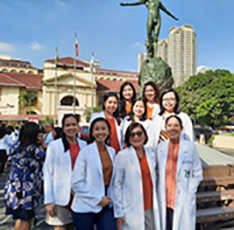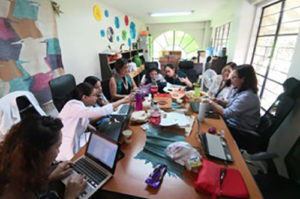My Journey in Adolescent Medicine...So Far
 Guest post by Ma. Emma Aleena-Llanto, MD
Guest post by Ma. Emma Aleena-Llanto, MD
“Adolescent Medicine…what’s that?” – My pathway
I asked that question twenty years ago as I reviewed the list of fellowship programs at the Philippine General Hospital. I was originally interested in Developmental Pediatrics or Child Protection but none were available at that time. That adolescents would warrant a “subspecialty” was quite a surprise for even a pediatrician like me. I asked to meet the adolescent medicine fellow and as I observed her at the Outpatient clinic, I became increasingly fascinated. It sure was a break from the pneumonia-diarrhea-rashes playbill of general pediatrics. And how nice that you could actually have a conversation with your patient. But I guess, what convinced me was the presence of a couple of increasingly puzzling teenagers at home. I took a virtual leap of faith, did the fellowship and was given the opportunity to be part of the development of Adolescent Health in my country.
A short history of adolescent health training
Adolescent Medicine was recognized early on in the Philippines through the pioneering work of Dr. Fe del Mundo and Perla Santos-Ocampo in the 1980’s. Two fellowship training programs were set up in the capital city of Manila, one at the Philippine General Hospital and the other at the Philippine Children’s Medical Center. Though set up in 1992, the fellowship programs produced only a handful of graduates. I surmised that the low recruitment rate was because it was relatively unknown subspecialty, and one which did not translate into a lucrative medical practice.
But the local landscape slowly shifted around 2015. Tertiary level government hospitals started sending trainees for Adolescent Medicine fellowship at the Phil. General Hospital. Starting from a single trainee per cycle, we have now accepted a total of 9 fellows from different parts of the archipelago. After their training, they return to their respective provincial hospitals to start their own adolescent services. Most will be teaching in medical schools in their region. Three have graduated and are setting up adolescent services in their respective hospitals.
Topics in Adolescent Medicine became more popular in post-graduate courses and round-table discussions. In 2015, the Philippine Pediatric Society (PPS) annual convention featured Adolescent Health as plenary topic for the first time. Earlier this year, PPS approved plans to integrate adolescent health care into the residency training program. If things go as planned, the integration will be done in 110 training hospitals nationwide.
Becoming visible
What pushed adolescent health a bit further into the horizon? At this time, adolescents got long overdue attention and were now part of the agenda of the top international agencies. At home, I can recall a couple of things. One, was the local rise in adolescent health concerns. There was an increase in adolescent pregnancies by 65% from 2000 to 2010; adolescents and young adults now make up 30% of newly diagnosed HIV cases and depression and suicides have been on the rise in the past three years. Adolescents were also in the news as lawmakers clashed on issues around reproductive health services, consent for HIV testing and lowering the minimum age of criminal liability.

Another reason for the shift may be attributed to the work done by various sectors consisting of Dept. of Health, NGOs, international agencies and medical societies, notably the Society of Adolescent Medicine of the Philippines, Inc. (SAMPI). SAMPI was founded in 1997 by a handful of adolescent medicine physicians among them Dr. Alicia Tamesis, Dr. Rosa Ma. Nancho and Dr. Regina Cailao. They invited professionals, dentists, psychologists, guidance counselors to form a multi-disciplinary organization. SAMPI conducted summer camps for adolescents but much of its work focused on medical education. Dr. Tamesis organized the first national convention in 2000 with Dr. David Bennett as the key note speaker. Other luminaries graced the biennial event, namely Dr. Robert Blum, Dr. Donald Greydanus, Dr. Dr. Kenneth Schonberg and our current IAAH President Dr. Susan Sawyer. At some point, these conventions brought together colleagues from Malaysia, Indonesia, Singapore and Australia.
Medical education partnerships
Notable efforts in medical education were done in partnership with other agencies. In 2009, the Department of Health tapped Dr. Rosa Ma. Nancho to produce the Adolescent Job Aid (AJA). This manual is still used in the training of health care workers for adolescent-friendly health facilities nationwide. In the aftermath of Typhoon Haiyan in 2013, UNICEF partnered with SAMPI to produce the handbook, “Responding to Adolescent Health Issues in Humanitarian Setting: An AJA-based Handbook for Primary Health Providers”. In 2015, I led the SAMPI team that produced the USAID- funded e-learning tool kit called Adolescent Health Education and Practical Training (ADEPT). The Department of Health and NGOs use ADEPT to train health care workers nationwide; medical schools use ADEPT videos to teach interviewing skills. SAMPI is currently part of the Adolescent Health Technical Working Group that was convened by the National Youth Commission.
Adolescent Medicine Fellowship
To upgrade the fellowship training, the SAMPI leadership decided to create a separate body to oversee training. In 2012, the Phil. Society of Adolescent Medicine Specialists (PSAMS) was organized under the umbrella of the Phil. Pediatric Society. PSAMS has since conducted board examinations to certify graduates of the two fellowship training programs. In 2019, PSAMS conducted workshops to harmonize the training programs, to re-write the curriculum using an outcomes-based format and review the board certification processes. Efforts to integrate adolescent health into the existing pediatric residency training program were also initiated with the full support of the PPS president, Dr Salvacion Gatchalian. We were going to launch the project on April 20,2020, a day before the PPS annual convention.


Impact of the COVID-19 pandemic
Needless to say, the pandemic changed our lives and our futures. We never saw the launch of the project because the PPS convention was cancelled and because we lost Dr. Gatchalian in the first wave of COVID-19 related deaths in late March. We are still in shock and disbelief. So adolescent health services and fellowship training have been disrupted. My hospital was designated a COVID-19 referral center so all other clinical services have been suspended. Adolescent Medicine fellows have been assigned as safety officers and now go on 24 -hour duty at the wards.
We carry on as best as we can. We learned quickly how to conduct our didactics and case conferences online. We know that mental health problems are on the rise and we are doing more training in this area. We made sure to take care of each other and organized regular Zoom support meet-ups. The fellows in turn have facilitated support groups among co-fellows from other subspecialties. We do not have skills (or the infrastructure) for telehealth so we are learning the ropes as our hospital establishes telehealth services. I believe that the revised fellowship program will include skills in online consultations and counseling as well as skills in online presentation.
Advocacy has also now shifted online, and SAMPI members are resource speakers for online discussions on adolescent health issues, notably mental health.
It is a brave new world for adolescent health and medicine. I do not know exactly what has changed for the moment only, or has changed irrevocably. What I do know is that change brings both challenges as well as opportunities. Knowing this, there’s a measure of apprehension but also excitement about the journey (that I plan to continue).
Recent Posts
News
About the Author
Ma. Emma Aleena-Llanto, MD, FPPS, FPSAMS, is the Chief of the Division of Adolescent Medicine at the Philippine General Hospital. She also serves as the President of the Philippine Society of Adolescent Medicine Specialists (PSAMS).
